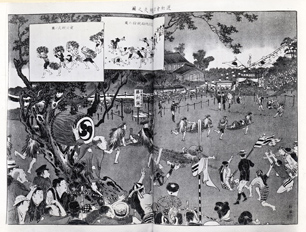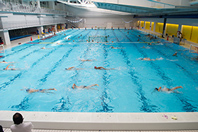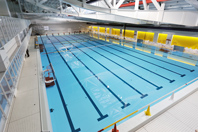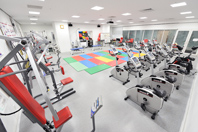Physical Education at Keio University—Building a Deeper Understanding of Sports (2)
The History of Physical Education at Keio University
Building a Healthy Body is Imperative to Cultivating Knowledge
Physical education has enjoyed a long tradition and history at Keio University. In the early years of the Meiji period, Keio adopted a Western-style concept of physical education based on the policy that “Students shall follow Keio’s ‘Gymnastics Rules’ and take part in a variety of physical activities as well as engage in diligent physical training.” It is known that there were swings and other equipment for playing and exercise at the Shiba Shinsenza school, before Keio moved to its current location in Mita. Additionally, Yochisha Elementary School, which was established in 1874, was quite advanced and unique for that time in that English education was provided by foreign teachers. However, as Fukuzawa believed it important to “grow an animal’s body: then develop a man’s mind,” he emphasized that children should build strong bodies before embarking on studies. Yoshiro Wada himself, a student of Fukuzawa and the founder of Yochisha, gave lessons in <i>jujutsu</i> inside the judo hall, which had been built within the school grounds.
Physical Education after WW2

With the implementation of the new university system in 1949, health and physical education became mandatory in Japanese universities. With this, as part of the health and physical education requirement, Keio University established two physical activity courses: the “basic physical activity” course, which was conducted once a week and ran through the academic year; and the “physical activity elective,” which was an intensive course conducted during long vacations and involved students choosing an activity from a range of options. However, as Hiyoshi Campus was at the time under requisition by the US army, it was impossible to run the basic physical activity course, and only the physical activity elective course, consisting of 28 subjects, was conducted with the cooperation of the Athletics Association. The basic physical activity course started in the following year in 1950, when Hiyoshi Campus was returned to Keio.
In 1961, the Keio University Institute of Physical Education was established, and with this, full-time faculty members teaching physical education, whose affiliations were scattered among different faculties, became members of the institute, further enhancing the quality of physical education at Keio University. It was also around this time that Keio’s physical education curriculum became more systemized.
The “Swimming for All Keio Students” Initiative

One noteworthy aspect of the basic physical activity course was that swimming classes were compulsory for Keio students who couldn’t swim. Swimming classes began the year after 1960, when the outdoor swimming pool in Hiyoshi was constructed, and they continued until the 1990s. The origin of this practice can be traced back to 1933, when then-Keio President Shinzo Koizumi put forward the idea of “swimming for all Keio students.” Koizumi made considerable effort to improve the students’ swimming skills so that they have the ability to protect themselves as well as save others from drowning. Every student had to be tested for their swimming ability, and those who could not complete a 50m swim were required to take swimming classes for their electives. It is said that Koizumi’s eagerness may have been due to the 1912 Titanic tragedy and the death of several students from Harvard University, with which Keio University already had close ties. However, with a number of revisions in the curriculum among other factors, the “swimming for all Keio students” initiative disappeared from around 1995. Swimming has now become an optional course, but the course is designed to give many students the chance to come in close contact and become comfortable with water.
Gender-Segregated Physical Activity Curriculum
The first female students were admitted to Keio University in 1946, three years prior to the introduction of the new university system, which made health and physical education compulsory in universities.
According to records, classes in physical activity in the 1952 academic year were segregated by gender: for the basic physical activity course, there were 7 modules each for male and female students; and for the physical activity elective course, there were 22 subjects for males and 14 for females. The basic physical activity course was primarily a lesson-based course, but for male students each module was taught by a different faculty member, whereas for female students one faculty member taught all 7 modules during the academic year. A portion of the basic physical activity modules for males were different to those for females, which included gymnastics and dancing. This style of teaching continued up until the university system changed and health and physical education courses were no longer compulsory. Today, gender segregation has completely disappeared from the university curriculum and in classes.
Physical Education as an Optional Course
When the Standards for Establishment of Universities were eased in 1991, health and physical education was no longer a requirement, and each university was left to their own discretion on how to design their own curriculum. Thus, from 1993 Keio University revised its curriculum so that health and physical education courses were optional and offered in most undergraduate faculties. At the same time, the class content also underwent dramatic reform to make them more understandable and accessible to students. Student number in each physical activity class was reduced to about thirty students, and lecture courses were given subtitles to emphasize the expertise of the faculty member in charge of the courses.
Additionally, with the revision of the curriculum at the Institute of Physical Education in 2004, the courses were reorganized into lecture-style courses, “Lecture on Physical Education” and “Seminar on Physical Education,” and practical courses, “Physical Activity A” and “Physical Activity B,” and Keio has since been offering a wide variety of options through these courses.
Keio University’s Sports Facilities
Swimming Pool: Basement Floor of the Kyosei-Kan (Collaboration Complex) on Hiyoshi Campus

These immaculate and fully-equipped swimming pools opened in 2008. There is a 50m pool, which can also be used for playing water polo, as well as a pool for high diving. Besides physical education classes, there are specific hours including lunch time when they are open to Keio students for recreational swimming.
Fitness Club: Basement Floor of the Kyosei-Kan (Collaboration Complex) on Hiyoshi Campus

The fitness club is equipped with barbells, dumbbells, pneumatic training machines, aero bikes, and much more. There is always staff at hand during opening hours. Other facilities include a training room run by the Student Health Insurance Union on Hiyoshi Campus, a training gym inside the gymnasium on Shonan Fujisawa Campus (no reservation needed), and tennis courts (reservations needed).
